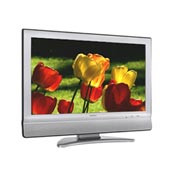Sharp LC26SH20U Flat Screen Televsion
![]()
![]()
![]()
![]()
![]()
![]()
![]()
![]()

Mid-size flat-panel LCD televisions are ubiquitous – we bought this one at a local supermarket. Even the bad ones are good, and the good ones will blow you away.
This is one of the reasonably good ones.
We bought the LC26SH20U television as a display monitor to assist in developing video software, but perhaps predictably, it has seen itself put to additional tasks. It can display off-the-air video, as well as composite, S-VHS and component video from whichever boxes you can find the remote controls for.
It’s probably worth mentioning that we bought this TV at a local supermarket after one of the large electronics retailers up here tried to bait-and-switch us. These things are everywhere, and everyone is trying to sell them for less than everyone else. Shop around.
The LC26SH20U is a very nice TV, and it requires virtually no setup. You’ll need to attach its base if you want to stand it on a table – allen key supplied – and find somewhere to plug it in. Its inputs are arranged along the bottom of its back panel, out of sight but easy to get at.
Desk space being more precious than pearls in house, we bolted the LC26SH20U to a wall. It has mounting bolt holes in its back plate for the purpose. Its various jacks are still accessible after it has been wall-mounted, a decided convenience. A third-party mounting system will be called for in this case – our experiences with these are touched on later in this review.
The remote control for the LC26SH20U is intuitive and unencumbered – it gets a lot done with relatively few buttons. The manual section for the remote is detailed, but largely superfluous – you can figure it out in less time than it takes to read the instructions.
The LCD panel for the LC26SH20U is breathtakingly sharp, and it adds a new dimension to whatever is displayed on it. Even fairly flat content, such as DVDs of broadcast television, seems to acquire a sense of depth. This sudden clarity isn’t without its cost, however – the LC26SH20U’s impeccable resolution shows up the flaws and limitations of early DVDs and bad film transfers much more effectively than a conventional glass television.
If you drive the LC26SH20U through its HDTV component video interface – entailing three video and two audio connections – its color is essentially perfect. While you can adjust it to your taste through the menu interface driven by the set’s remote control, you’re unlikely to want to do so. The color fidelity is nowhere near as good for S-VHS video, which required a considerable degree of adjustment on our set.
The LC26SH20U’s LCD panel does have some speed issues. Viewed from off-center, rapidly moving objects on screen appear to leave visible ghosts behind themselves, producing momentary strange facial expressions and speed blurs at times. The effect isn’t unduly troubling, but it takes some getting used to. It won’t be much of a concern for normal viewing, at normal angles.
With four video inputs – one composite, two S-VHS and one component – the LC26SH20U is adequately supplied with choices, but not generously so. A few more input channels would have been an asset, especially for users with a lot of video toys. The set lacks front-mounted jacks to play portable devices, such as camcorders, through.
You can also connect most video devices to the LC26SH20U through its RF input, of course, but you probably wouldn’t want to admit to doing so.
The slightly slow response time of the LC26SH20U’s panel is arguably its only shortcoming, and it’s hardly a deal-breaker unless you insist on trying to watch it from the side, an unlikely issue. This is one of the nicer HDTV LCD televisions we looked at – it cost somewhat less than the other contenders, while giving up little.
Honorable mention for this one goes to the Omnimount U2, the mounting system we used to attach our LC26SH20U television to its wall. We tried several lesser wall mounting systems, one of which came within a heartbeat of collapsing and dropping the TV. The Omnimount mount cost quite a bit more than the cheap mounts it replaced, but it’s built to last and it was accompanied by exemplary instructions. The U2 mount package included a sheet of numbered screw sets, and an exhaustive list of the televisions they worked with. The lesson in all this is that Home Depot is a great place to buy lumber, and perhaps less so for television mounts that just have to stay up there.